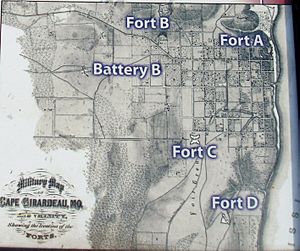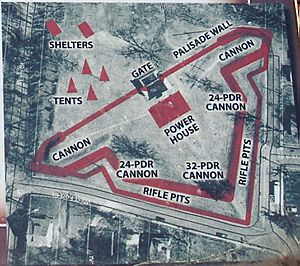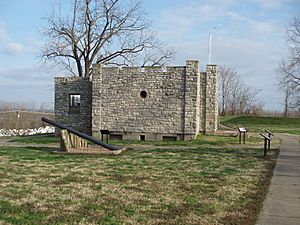Fort D facts for kids
Quick facts for kids |
|
|
Fort D
|
|
 |
|
| Location | 920 Fort St Cape Girardeau, Missouri |
|---|---|
| NRHP reference No. | 100004219 |
| Added to NRHP | August 1, 2019 |
Fort D is an old fort from the American Civil War. It sits right next to the Mississippi River in Cape Girardeau, Missouri, USA. This fort was built to protect the city during the war.
Building Fort D: A Look Back
Work on Fort D started on August 6, 1861. A man named Lieutenant John Wesley Powell from Illinois led the project. Later, Powell gathered a group of men from Cape Girardeau to join the Union army. These men became part of Battery F, 2nd Illinois Light Artillery.
After training, Powell's group went to Pittsburgh Landing, near a small church called Shiloh. During the Battle of Shiloh on April 6, 1862, Powell was shot in the wrist. His arm had to be removed to stop infection. Years later, in 1869, John Wesley Powell, with only one arm, became famous. He led the first successful trip down the Colorado River through what he named "the Grand Canyon".
The fort's strong dirt walls are the original ones built in 1861. They were fixed up in 1936. A wall of upright logs, called a palisade, likely formed the back of the fort. It probably had a gate for entry. A gap in the south wall might have been a "sally port." This allowed soldiers to quickly get to the rifle pits below the main wall.
The fort had five large cannons. Three were 32-pounders and two were 24-pounders. A 32-pounder cannon could fire a 32-pound solid cannonball over a mile! These cannons were very heavy, weighing more than four tons with their carriages.
Union soldiers from Illinois, Missouri, and other states guarded Fort D. The fort was never directly attacked in a major battle. The main fight in the area, the Battle of Cape Girardeau, happened west of the city in 1863.
Other Forts in the Area
Fort D is the only fort from the Civil War still standing in this area. Other forts were built but are no longer there:
- Fort A was north of downtown Cape Girardeau on a high hill. It even had a windmill inside!
- Fort B was located where Academic Hall at Southeast Missouri State University is now.
- Fort C was built at the end of Bloomfield Road.
There were also smaller defenses. These included Battery A, Battery B, and rifle pits along Perry Avenue.
Saving Fort D for Today
Fort D was saved from being torn down in the early 1900s. The dirt walls were repaired in the 1930s by the Works Progress Administration (WPA). The WPA was a program that created jobs during the Great Depression. The stone building, called a blockhouse, was also built by the WPA in 1936. It has been used for different things since then.
In 2019, Fort D was added to the National Register of Historic Places. This means it's recognized as an important historical site.




